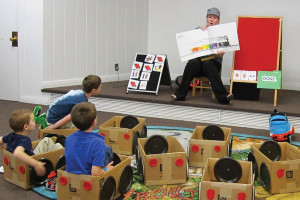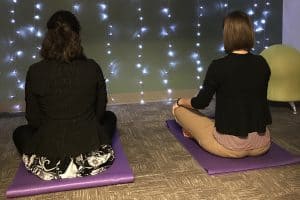Louisville (Ohio) Public Library opened an innovative Sensory Space in August 2018 with the help of a $50,000 Library Services and Technology Act (LSTA) grant. It offers teen sensory relaxation sessions, adult sensory exploration, sensory storytimes, and other activities for patrons on the autism spectrum. Louisville is one of the first public libraries to offer a free multisensory environment, which is housed in the library’s Discovery Center.
Motor coordination, concentration, color recognition, understanding cause and effect—these are some of the skills Louisville Public Library hopes to amplify in the children and adults with special needs who use its new Sensory Space. It’s not a large room; it can hold only 24 individuals at a time, and it is often at capacity. But it is a unique space for sensory exploration and programming. “It’s the only library in the state of Ohio offering something like this,” Library Director Jason Buydos says. “It is potentially an example of what libraries could or should be offering nationally.”
The idea came from two staff members who have children on the autism spectrum. Through an LSTA grant, the library built a space whose visual and auditory environment is controlled and designed for children and adults on the spectrum. Those with sensory integration issues find the Sensory Space particularly helpful, but even those who don’t need help with motor skills will enjoy the experience. “Although the Discovery Center is designed for the special needs community,” Buydos says, “all of our patrons can benefit from the programming hosted in the sensory space.”
The space is divided into two sections to help tailor the experience to specific needs. One section is filled with tactile objects providing physical interaction, delighting those who are understimulated in daily life and helping those with early onset dementia. These objects include an interactive balance beam, a musical vibration bench, and touch-sensitive walls. For example, the IRiS Musical Touch Wall from Experia helps users develop cause-and-effect skills, color and number recognition, and hand-eye coordination through its use of vibrant LED lights and touch sensitivity.
The second section is a relaxation area. Designed to limit stimuli for those who are overly stimulated, like children with attention-deficit/hyperactivity disorder (ADHD), the relaxation section is full of soothing colors, dim lights, and optical illusions.
The Discovery Center is designed for the special needs community, but all our patrons benefit.Jason Buydos, director of the Louisville (Ohio) Public Library
The Discovery Center hosts weekly programs including storytime, adult relaxation yoga, and play time. The space can also be specially reserved for groups to ensure that everyone has full access to all that the room has to offer.
The center opened its doors in August 2018 and was met with overwhelming interest and support from the community and throughout Ohio. Within its first week of operation, the Sensory Space saw more than 1,000 visitors—quickly reaching a goal that the library had hoped to achieve over the first year.
Staffers give frequent tours of the space to other librarians in the hope that this programming model will be duplicated at other libraries throughout the country. At the conclusion of every tour, excited librarians leave the building abuzz with numerous ideas that they take back to their communities.
Area schools and even a local hospital have contacted the library to develop partnerships, and a nearby college teaches an education course in the Sensory Space as part of its curriculum for special needs educators.
Kristen Werstler, activities and events department assistant, has noticed first-hand the impact that the Sensory Space has had on the community. “A class of special needs students regularly attends our storytimes,” Werstler says. “We have four Noisy Sound Walls, each of which depicts a different scene—a farm, a jungle, a city, and the galaxy. When I read a book about farm animals, I have the children take turns pressing the walls so we hear all the farm animals. This helps them associate real sounds with the words on the page, further developing their cognitive recognition.”
“I can mostly speak for my daughter, a teen with Asperger’s high-functioning autism and ADHD,” says library patron Deborah Long. “The Sensory Space is one of her favorite places on earth.”


